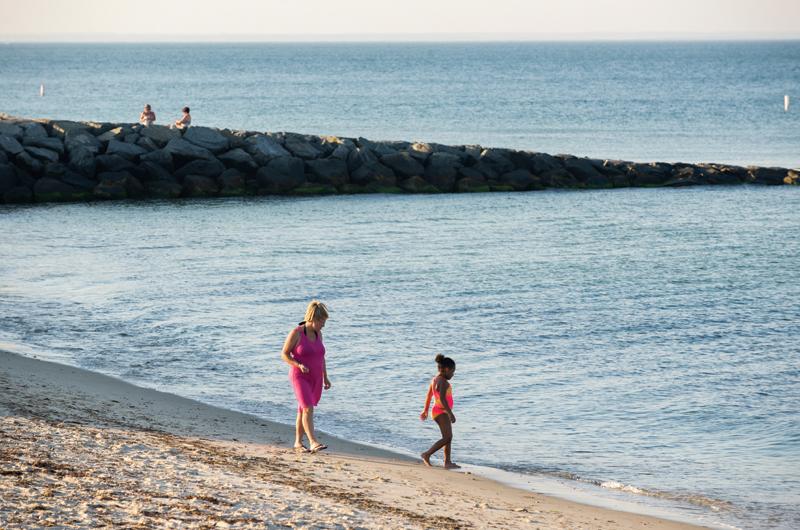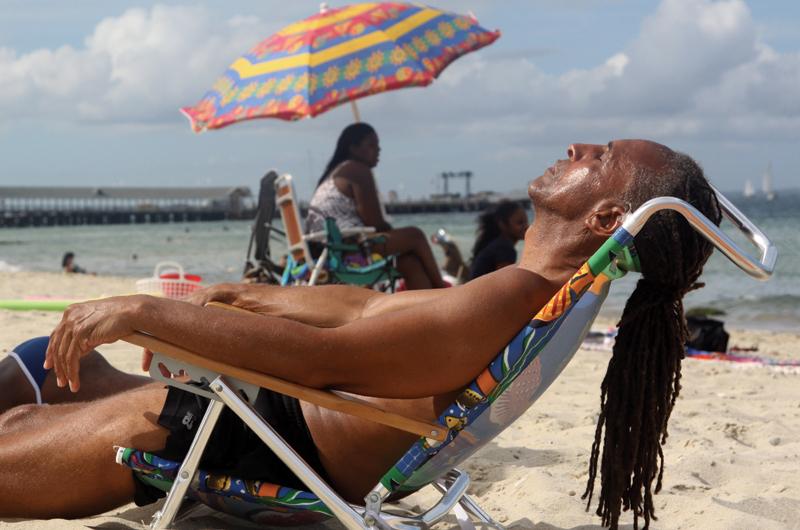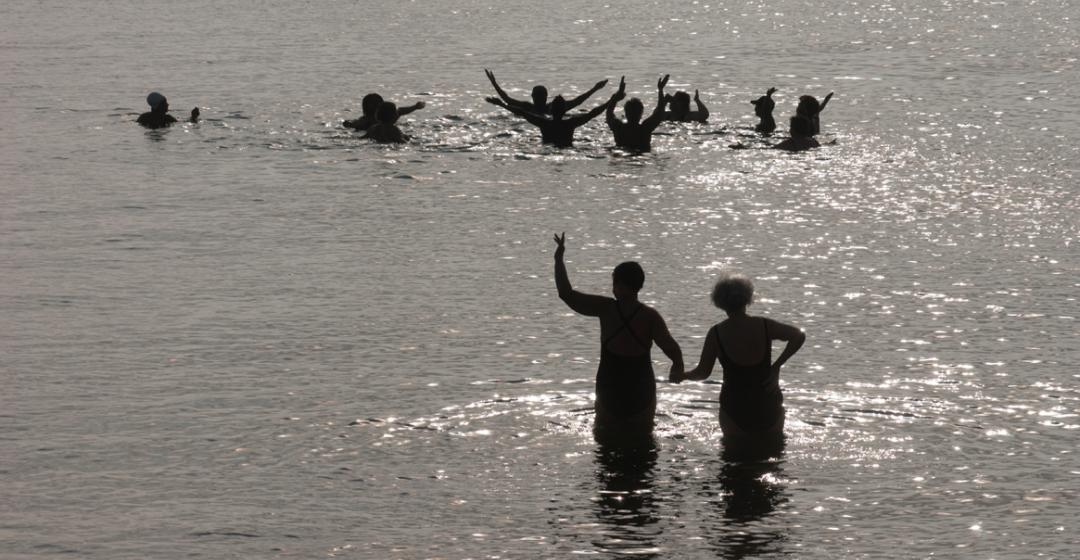I am most assuredly not a beach person, yet I delight in informing the world that I have spent my almost sixty years of Vineyard summers living up the street from one of the Island’s most famous beaches. It’s not the prettiest by far. It’s not the most secluded or the most exclusive. It’s not even the most notorious. Most of those are up-Island and access is granted to those in the know, those with parking stickers, or those willing to take off their clothes. Rather, my beach is the town beach of Oak Bluffs that now goes proudly, publicly, and more than a little controversially by the name of what was once a shared in-joke: the Inkwell.
When I arrived with my parents on the Island some six decades ago, various towns had their own stretches of beach, the perquisites of which were jealously guarded, as we found out when we were gently asked off of Edgartown’s Lighthouse Beach one summer. (Back then, they could tell that we didn’t live in Edgartown, ’cause no black people did!) The Oak Bluffs town beach was considerably more egalitarian and was right at the end of our street at the foot of Tuckernuck Avenue. It offered a curve of beach protected by a seawall and came complete with a floating raft to which one could swim and on which one could sun. Across the street, the Sea View Hotel, a ramshackle remnant of the town’s gilded age, offered refreshment: a trip across the dark lobby took one into the bar where a cool drink and libations could be had.
The town beach was adjacent to Pay Beach, where there were changing rooms and a lifeguard. I vaguely remember a concession stand of some sort, but it could not have rivaled the thrill of heading into the Sea View. I later learned Pay Beach had been segregated in the town’s early days, but when my family arrived in the late 1950s the segregation was financial. Pay Beach’s facilities were available for a nominal sum (I think it cost a dime), but the town beach was free and it was ours! As the town changed complexion and became more and more African American, the in-joke name that was whispered among certain folks was “the Inkwell.” It was a private joke that was never, ever uttered in public company, rather an affectionate sobriquet bestowed on the beach by those who swam and sunned there.

There are other tales of how the beach came by its now world-famous name. Some suggest that it was labeled derisively by whites as the beach and the town blackened up. And still others suggest, somewhat curiously, that it was because of some of the Harlem Renaissance writers who summered in Oak Bluffs. (Dorothy West was most assuredly not a beachgoer!) Whatever the rationale, the name has stuck, taken on a life of its own, and is now proudly emblazoned on T-shirts, baseball caps, and hoodies. There was a 1994 film about it, although it was not filmed on the Vineyard, and there is even a car sticker that proudly proclaims INK – to the despair of some of the Island’s more politically aware residents.
The beach’s name moving from a whisper to a scream is perhaps the most obvious change that the curve of sand has gone through. Indeed, the beach has morphed with the town and the times. Each summer adds another layer of lore and each hour of the day has its particular beach denizens. In the early days, there was the tale of the woman who floated out to sea: Gertrude Smith. She was noted for her graceful strokes back and forth, up and down, between jetties. One day, she headed out and got caught in one of the Island’s notorious riptides. She had the good sense to float, but was carried so far out that rescue came in the form of a passing boater.
Smith was one of the Polar Bears, a more than seventy-year-old organization that began as a group of friends who took a morning dip before heading off to their summer jobs. The group still exists and now welcomes visitors and stalwarts every summer at the beach at 7:30 each morning. Mondays are special, with a potluck breakfast drawing swimmers and non-aquatic admirers. The Polar Bears are a part of my beach memories, because my mother was an early member, and I recall the cries from friends under her window calling her to walk down to the beach with them for their daily dip. I still know some of the more senior members who date back to her times: the Dowdell sisters, whose centenarian mother would join the group on occasion, plus Phyllis DeChalus and Fran Gaskin. I still miss some of those who have gone, like Eloise Allen. I cherish Mom’s Polar Bear sweatshirt and the memories it carries, but I’m a late sleeper and a different kind of water baby.
I’m not a part of the beach’s midday crowd either. I watch the day folks as they pass by on their way to the beach hauling wagons full of impedimenta. They arrive like Grant taking Richmond and set up camp for the day, complete with umbrellas, beach chairs, coolers, and more. Mothers are happy to converse with each other and perhaps indulge in a game or two of bridge or bid whist while youngsters paddle about and form lifelong summer friendships. Someone’s eye is always seaward and the beach-going village raises the children together.

All are not parents; for some, the beach simply provides an outdoor living room where sun and sand, punctuated with an occasional dip when the sun’s heat is too much, make for the perfect summer day. No one exemplified this beachgoer better than Lois Lippman, who lived up the street. They should name a stretch of the beach for her. For decades, if the sun was out and she was on Island, she could be found in her usual spot on the beach: greeting her public, working on her sunglow, and generally basking in the warmth of community that this particular stretch of beach celebrates.
Today’s beach has become so popular in the minds of Island visitors that it ranks just after the Tabernacle on TripAdvisor’s list of things to do in Oak Bluffs. Folks vie with one another for a spot for their blankets and the ability to say they’ve spent some time at the Inkwell. The meeting and greeting are epic and the networking so astounding that I have been known to wonder aloud if folks have pockets sewn in their bathing suits for business cards! The good times continue as each new generation creates its own memories of the iconic beach.
As day turns to sundown, a different set of beach lovers arrives, those who may not want the camaraderie of the early morning or the good-time crowds of midday. Late afternoon, the people thin out. Wagons are packed up, children rounded up, and thoughts turn to dinner and evening activities. That’s when I venture out. I do a brief stroll at water’s edge and marvel at the history the beach has witnessed: family gatherings, memorial services, weddings, and secular baptisms in the chilly waters of Nantucket Sound. A litany of names runs through my mind as I walk. I think of friends and family who have loved these waters, always ending with my parents, who gave me to the Vineyard. Then I pack up my belongings, bid the water goodbye for a while, and head back home to my house up the street from the beach with the problematic name.




 16 comments
16 comments
Comments (16)